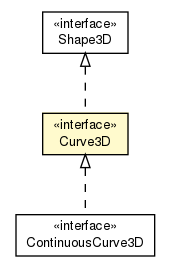
|
||||||||||
| PREV CLASS NEXT CLASS | FRAMES NO FRAMES | |||||||||
| SUMMARY: NESTED | FIELD | CONSTR | METHOD | DETAIL: FIELD | CONSTR | METHOD | |||||||||

public interface Curve3D
Interface for 3D space curve. Curve can be continuous, or a set of continuous curves.
| Nested Class Summary |
|---|
| Nested classes/interfaces inherited from interface math.geom3d.Shape3D |
|---|
Shape3D.EmptySet3D |
| Field Summary |
|---|
| Fields inherited from interface math.geom3d.Shape3D |
|---|
ACCURACY, EMPTY_SET |
| Method Summary | |
|---|---|
Collection<? extends ContinuousCurve3D> |
getContinuousCurves()
Returns the collection of continuous curves which constitute this curve. |
Point3D |
getFirstPoint()
Get the first point of the curve. |
Point3D |
getLastPoint()
Get the last point of the curve. |
Point3D |
getPoint(double t)
Gets the point from a parametric representation of the curve. |
Point3D |
getPoint(double t,
Point3D point)
Same as getPoint(t), but gives the point as a parameter. |
double |
getPosition(Point3D point)
Get position of the point on the curve. |
Curve3D |
getReverseCurve()
Returns the curve with same trace on the plane with parametrization in reverse order. |
Collection<Point3D> |
getSingularPoints()
Returns a set of singular points, i. |
Curve3D |
getSubCurve(double t0,
double t1)
Returns a portion of the original curve, delimited by two positions on the curve. |
double |
getT0()
Get value of parameter t for the first point of the curve. |
double |
getT1()
Get value of parameter t for the last point of the curve. |
double |
project(Point3D point)
Returns the position of the closest orthogonal projection of the point on the curve, or of the closest singular point. |
Curve3D |
transform(AffineTransform3D trans)
Transforms the curve by an affine transform. |
| Methods inherited from interface math.geom3d.Shape3D |
|---|
clip, contains, getBoundingBox, getDistance, isBounded, isEmpty |
| Method Detail |
|---|
double getT0()
double getT1()
Point3D getPoint(double t)
Point3D getPoint(double t,
Point3D point)
Point3D getFirstPoint()
getPoint(getT0()).
Point3D getLastPoint()
getPoint(getT1()).
Collection<Point3D> getSingularPoints()
double getPosition(Point3D point)
point - a point belonging to the curve
double project(Point3D point)
point - a point to project
Curve3D getReverseCurve()
Collection<? extends ContinuousCurve3D> getContinuousCurves()
Curve3D getSubCurve(double t0,
double t1)
t0 - position of the start of the sub-curvet1 - position of the end of the sub-curve
Curve3D transform(AffineTransform3D trans)
transform in interface Shape3D
|
||||||||||
| PREV CLASS NEXT CLASS | FRAMES NO FRAMES | |||||||||
| SUMMARY: NESTED | FIELD | CONSTR | METHOD | DETAIL: FIELD | CONSTR | METHOD | |||||||||